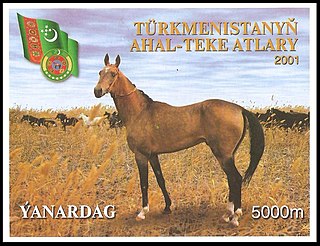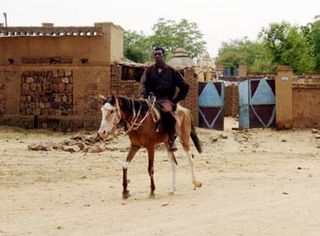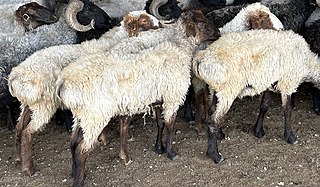
The Akhal-Teke is a Turkmen horse breed. They have a reputation for speed and endurance, intelligence, and a distinctive metallic sheen. The shiny coat of the breed led to their nickname, "Golden Horses". These horses are adapted to severe climatic conditions and are thought to be one of the oldest existing horse breeds. There are currently about 6,600 Akhal-Tekes in the world, mostly in Turkmenistan, although they are also found throughout Europe and North America. Akhal is the name of the line of oases along the north slope of the Kopet Dag mountains in Turkmenistan. It has been inhabited by the Tekke tribe of Turkmens.

The Kinsky Horse is a Czech breed of warmblood sport horse. It was bred by the Kinsky family in the Kingdom of Bohemia, and is now one of four warmblood sport horse breeds reared in the Czech Republic, the others being the Czech Warmblood, the Slovakian Warmblood and the Moravian Warmblood. It was for many years absorbed into the Czech Warmblood; a separate stud-book was established in 2005. It is characterised by an unusual golden-yellow coat, though other colours are also seen.

The Nez Perce Horse is a spotted horse breed of the Nez Perce tribe of Idaho. The Nez Perce Horse Registry (NPHR) program began in 1995 in Lapwai, Idaho and is based on cross-breeding the old-line Appaloosa horses with an ancient Central Asian breed called Akhal-Teke.

The Turkoman horse, or Turkmene, was an Oriental horse breed from the steppes of Turkoman desert. Its closest modern descendant is thought to be the Akhal-Teke. It influenced many modern horse breeds, including the Thoroughbred horse. Some horses bred in Iran and Turkmenistan today are still referred to as Turkoman, and have similar characteristics.

The Tersk or Tersky is a Russian breed of light riding horse of Arab type. It was bred at the Tersk Stud in Stavropol Krai in the North Caucasus between about 1925 and 1940.

The Karabakh horse is a mountain-steppe racing and riding horse breed. It is named after the Karabakh region, from which the breed originates. The breed is noted for its good temperament and speed; in 2004, a Karabakh horse named Kishmish from an Aghdam stud farm covered 1,000 metres (3,300 ft) in 1.09 minutes and 1,600 metres (5,200 ft) in 1.52 minutes.

The Kathiawari or Kathiawadi is an Indian breed of horse. It originates in the Kathiawar peninsula of Gujarat in western India, and is associated with the Kathi people of that area. It was originally bred as a desert war horse for use over long distances, in rough terrain, on minimal rations. It is closely related to the Marwari horses of Rajasthan; both breeds have been influenced by imported Arab horses. It is found in all colours except for black, and is most commonly chestnut. In the past it was used as a war horse and cavalry mount. Today it is used for riding, in harness and for sports; it may be used as a police horse and for the sport of tent-pegging. A stud-book is kept by the Kathiawari Horse Breeders' Association, which also organises annual shows.

The Knabstrupper or Knabstrup is a Danish breed of warmblood horse. It is principally a riding horse, but is also used as a harness horse and as a circus animal.

The Lundy Pony is a British breed of pony bred on Lundy Island in the twentieth century.
Agriculture in Central Asia provides a brief regional overview of agriculture in the five contiguous states of former Soviet Central Asia – Kazakhstan, Kyrgyzstan, Tajikistan, Turkmenistan, and Uzbekistan. Two other countries that are sometimes classified as Central Asian – Afghanistan and Mongolia – are included in this overview because of their substantially different background.
The Lokai, a mountain horse bred in Tajikistan, is used as a riding horse, a packhorse, or even sometimes a light draft horse. Although small, the breed is agile and hardy. The breed was developed by crossing native mountain horses with a mixture of Central Asian and European bloodlines.

The Brazilian Sport Horse or Brasileiro de hipismo is a modern Brazilian breed of warmblood horse. It was bred as a sport riding horse for competitive equestrian sports, particularly show jumping, dressage and three-day eventing.

The Novokirghiz or New Kirghiz is a modern Kyrgyz breed of horse. It was developed in the Kirghiz Soviet Socialist Republic in the mid-twentieth century through cross-breeding of the traditional Kyrgyz Horse of the region with introduced horses of Thoroughbred, Don and Anglo-Don stock.

The Gelderlander is a Dutch breed of warmblood horse. It was bred in the province of Gelderland in the Netherlands as a carriage horse capable also of farm work. It declined in popularity in the mid-twentieth century. In 1965 it was one of the foundation breeds of the Dutch Warmblood or KWPN, the other being the heavier Groninger horse from the north. It is registered in a division of the Royal Dutch Warmblood Horse Studbook, which also has divisions for the Dutch Warmblood and for the Dutch Harness Horse.

Yanardag is an Akhal-Teke stallion owned by the former President of Turkmenistan, Saparmurat Niyazov. The stallion is depicted on the coat of arms of Turkmenistan, on a 2001 miniature sheet Turkmenistan postage stamp, and in other Turkmen national representations, and he is also often featured in newspaper and magazine articles.

The French Trotter is a French breed of trotting horse bred for racing both ridden and in harness. It was bred specifically for racing in the 19th century (1800s), principally in Normandy in north-western France.

Western Sudan Pony is an exonym for a Sudanese breed or group of breeds or ecotypes of small horse or pony. These are distributed principally in southern Darfur and south-western Kordofan, extending into southern Chad, and are known generically as Gharbaui ("western") or by a variety of regional names including Darfur Pony and Kordofani.

The list of Turkmenistan-related articles is below

The Yomut or Yomud is a Turkmen tribe that lives in Western and Central Asia, including Gorgan, Iran; Turkmenbashi, Turkmenistan; the eastern Caspian shores; Khiva, Uzbekistan; and Dashoguz, Turkmenistan.

Saryja is a breed of fat-tailed sheep developed on the territory of Turkmenistan. The breed was developed through a long-term selection of Turkmen breeds of fat-tailed sheep, which had a high content of fluff in wool. The breed received its name from the village of Saryja, located near the Turkmen city of Mary.


















